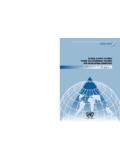Transcription of Education and Training in the Auto Manufacturing Industry ...
1 Hooi Lai Wan Education and Training in the auto Manufacturing Industry 39. Original Article Education and Training in the auto Manufacturing Industry : a comparative analysis between Japan and Malaysia Hooi Lai Wan Osaka School of International Public Policy (OSIPP), Osaka University, Japan Abstract This paper addresses the question of whether there is in fact a single model of Japanese Education and Training practices in Malaysia. This is done by analyzing survey-based data sets recently obtained from samples of Japanese and locally owned firms in the same Industry . Research on auto Manufacturing companies was carried out. Here a comparative study was made between a Japanese auto Manufacturing company and three other local auto manufac- turing companies - two with Japanese interests and one fully Malaysian-owned. The objective of this research is to reveal to what extent Japanese Education and Training practices are intro- duced and practiced in Malaysian auto Manufacturing companies, since the implementation of the Look East Policy.
2 As it has been almost 20 years that the Look East Policy was in practice, emulation of the Japanese system of management in the local enterprises should be significant. Key words: Education and Training , job rotation, on-the-job Training , off-the-job Training , mentor system, Human Resource Development Fund. Introduction Japanese scholars and management consultants have also been invited to present papers at inter- After the oil shock, the transferability of national conferences and to conduct seminars. the various elements of the Japanese manage- Thus, an understanding of Japanese-style man- ment system has become a subject of consider- agement developed among the local people. able interest. The Japanese management system However, to what extent has the Japanese-style is considered to be one of the key factors ac- management model been successfully transported counting for the success Japanese achieved in to Malaysia?
3 Improving productivity and the quality of the goods and services they produce. In Malaysia, the Prime Minister enunciated The Look East Objective Policy in late 1981 with Japan specifically in Since the Look East Policy has been in mind. Learning from the Japanese has been practice for almost 20 years, local enterprises in vogue for some time in Malaysia. emulation of the Japanese system of manage- After the Malaysian government developed ment should remain significant. As human re- the Look East Policy, information concerning source management is one of the key factors for Japanese management practices has been circu- the success of the auto Manufacturing compa- lated by the mass media, through numerous ar- nies in Japan, human resource management prac- ticles in international journals and in books. tices should have been introduced to the local training8 39 14/4/32, 1:01 AM. 40 Human Resources for Health Development Journal (HRDJ) Vol.
4 5 No. 1 - 3, January - December 2001. auto Manufacturing companies. However, for the Training and Education for all levels of employ- purpose of this paper, only Japanese Education ees with funding from the company. Worker and Training are discussed. The objective of this productivity gains have been enhanced through research is to reveal to what extent Japanese the application of suggestion programs and such Education and Training practices are introduced small group activities as quality control circles and practiced in Malaysian auto Manufacturing (QCCs). companies since the implementation of the Look Ouchi and Jaeger(4) states that the tradi- East Policy. tional philosophy of Japanese Education and This is done by analyzing survey-based Training emphasizes on-the-job Training and oth- data sets recently obtained from samples of Japa- ers. On-the-job Training plays a principal role nese and locally owned auto Manufacturing com- and other forms of Training are introduced only panies.
5 The auto Manufacturing Industry in as a supplement. OJT is basic for skilled work- Malaysia is a growing Industry and most of these ers, while a specially designed off-JT Education companies have Japanese interests. Here a com- and Training system internal to the firm is aimed parative study was made between a Japanese mainly at the office and technical staff. Skill auto Manufacturing company and three other Training based on on-the-job Training techniques local auto Manufacturing companies - two with in Japan is related to job mobility and job rota- Japanese interests and one fully Malaysian- tion(5-7). Training programs are regularly injected owned. with sessions of off the job Training to instill intellectual skills into employees. To preview the main findings and conclu- sions of this research, it appears that there is not In Malaysian organizations, the most popu- a single model of Education and Training prac- lar OJT techniques are coaching which includes tices operating in Malaysia and that the Malay- job rotation and self-learning.
6 Off-JT is con- sian enterprises have not designed their educa- tracted to outside agencies to train managerial tion and Training practices after those of their employees. Recently, correspondence courses parent company - Japanese, American or other- have also come into use as an educational wise. However, it does suggest the existence of method. Most Malaysian employees are spon- some consistent sets of Education and Training sored by their employers, and wage payment behavior among the companies, though these during the Training period is guaranteed. Train- patterns may not be representative of Malaysian ees are required to continue working in their Education and Training behavior. firms on completion of Training , but if they want to change firms to get a better job, management This paper is divided into four parts: (1) a does not have any effective means by which to review of related literature (2) analytical frame- prevent them from moving.
7 Work and research methodology (3) research findings and (4) implication of these findings for Malaysia. Analytical Framework and Research Methodology A Review of Related Literature The approach is to target local enterprises The major contributors to the literature on as much as possible in the collection of primary Japanese human resource management practices data through a set of questionnaires as well as include both foreigners and the Japanese them- in-depth interviews with the human resource selves. Foreign contributors include Abegglen(1), director and some employees of each company. Levine(2), Whitehill(3) and others. One of the Questionnaires written in English and structured representative characteristics inherent in the Japa- with an answering scale for early response were nese style of human resource management is mailed out to most of the auto Manufacturing training8 40 14/4/32, 1:01 AM. Hooi Lai Wan Education and Training in the auto Manufacturing Industry 41.
8 Companies in Japan and Malaysia. Research Findings The first step was to contact the Human It has been hypothesized that since the Resource Department of each of the companies Look East Policy has been in practice for almost by telephone. A meeting with the Human Re- two decades, the emulation of Japanese educa- source Department was arranged and a general tion and Training practices in Malaysian compa- outline of this research's aim and methodology nies should be significant. The extent of Japa- was mailed to them in advance of the meeting. nese Education and Training practices introduced At the first meeting with the Human Resource and practiced in Malaysian companies should Department, the theme, the purpose, general be reflected in the management policies of outline, method, and details of this study were Malaysian companies. However, though it can- explained. Three requests were made: (i) to not be denied that some elements of Japanese complete the questionnaire (ii) permission to Education and Training behavior do exist among interview the human resource staff and (iii) per- the companies, the transference of Japanese mission to privately interview company employ- Education and Training practices into Malaysian ees in different positions within the company - companies would take longer than expected due managers, engineers and clerical staff.
9 Inter- to many factors among them cultural differences. views were carried out in a private room and A comparison of Education and Training lasted for an hour to an hour and a half. Tape practices of the Japanese companies with those recordings of each interview were made. Notes of locally owned firms in the auto manufactur- were also taken during the interview and after ing Industry reveals a number of similarities and each interview, a summary of each interview was differences. The degree of similarity is high in drafted. the fields of on-the-job Training and off the job The data collected were then analyzed. Training . It is low in such areas as self-develop- First, the taped interviews were transcribed into ment and intensity of Training . The main differ- written form. This was done repeatedly in an ence here between the two countries is that Japa- effort to retain the essence of what the individual nese employees are given constant and consis- was trying to say.
10 Then answers from the ques- tent Training throughout their career. Malaysian tionnaires were compiled and summarized. The enterprises, however, carried out little Training summarized responses to each question were for its employees, at least not until recently. compiled and compared. The answers to ques- For the purpose of this comparison, one tions relating to a similar topic were tabulated in major auto Manufacturing company in Japan and a series of tables. Each table was analyzed to three locally owned assembling companies are identify key trends. These key trends were then taken as examples - J1 Motor Corporation, M1. tabulated in a second chart. Overall emerging Motor Corporation, MJ1 Motor Corporation and themes were then identified and these results MJ2 Motor Corporation. Ownership of the above were used for the writing of this paper. The organizations is as summarized in Table 1. research findings will be presented in greater detail in the following section.












